Australian Institute of Professional Counsellors: CHCPRP001 Assessment
VerifiedAdded on 2023/03/22
|36
|10051
|33
Homework Assignment
AI Summary
This assessment book for CHCPRP001, "Develop and Maintain Networks and Collaborative Partnerships," focuses on understanding and applying networking and collaboration principles within a community services context. The assignment explores the definitions of networking and collaboration, their differences, and the importance of principles like engagement, inclusivity, and equity. It examines the potential benefits of collaborative relationships for individuals, organizations, and clients, particularly within the context of case management for at-risk populations. The assessment delves into the evaluation of collaborative efforts, requiring the identification of relevant questions to assess improved worker and organizational performance. Challenges and limitations of networking and collaboration are also addressed, with the goal of understanding potential obstacles and promoting effective practices. The assignment covers benefits, challenges and evaluation of networking and collaboration.
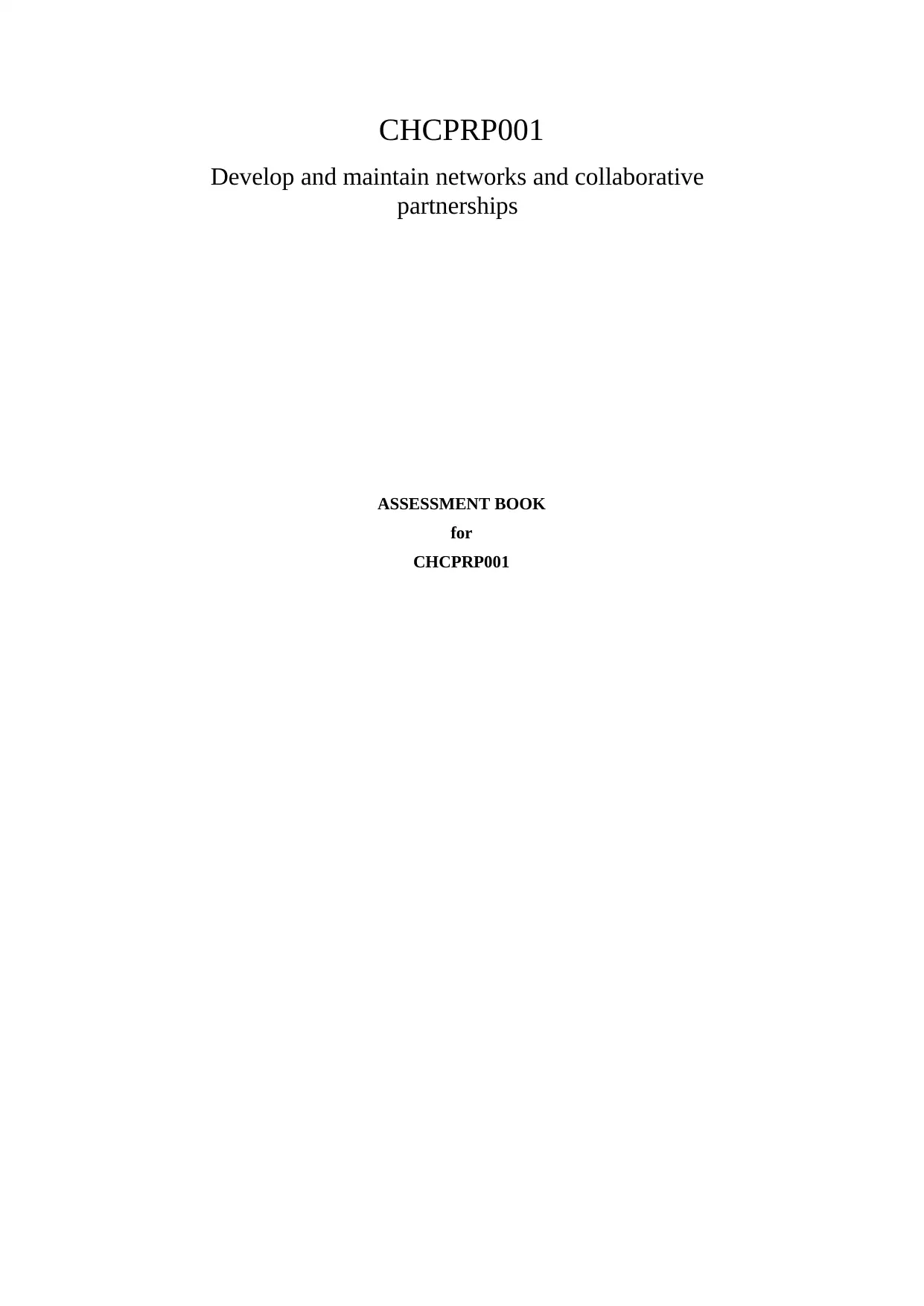
CHCPRP001
Develop and maintain networks and collaborative
partnerships
ASSESSMENT BOOK
for
CHCPRP001
Develop and maintain networks and collaborative
partnerships
ASSESSMENT BOOK
for
CHCPRP001
Paraphrase This Document
Need a fresh take? Get an instant paraphrase of this document with our AI Paraphraser

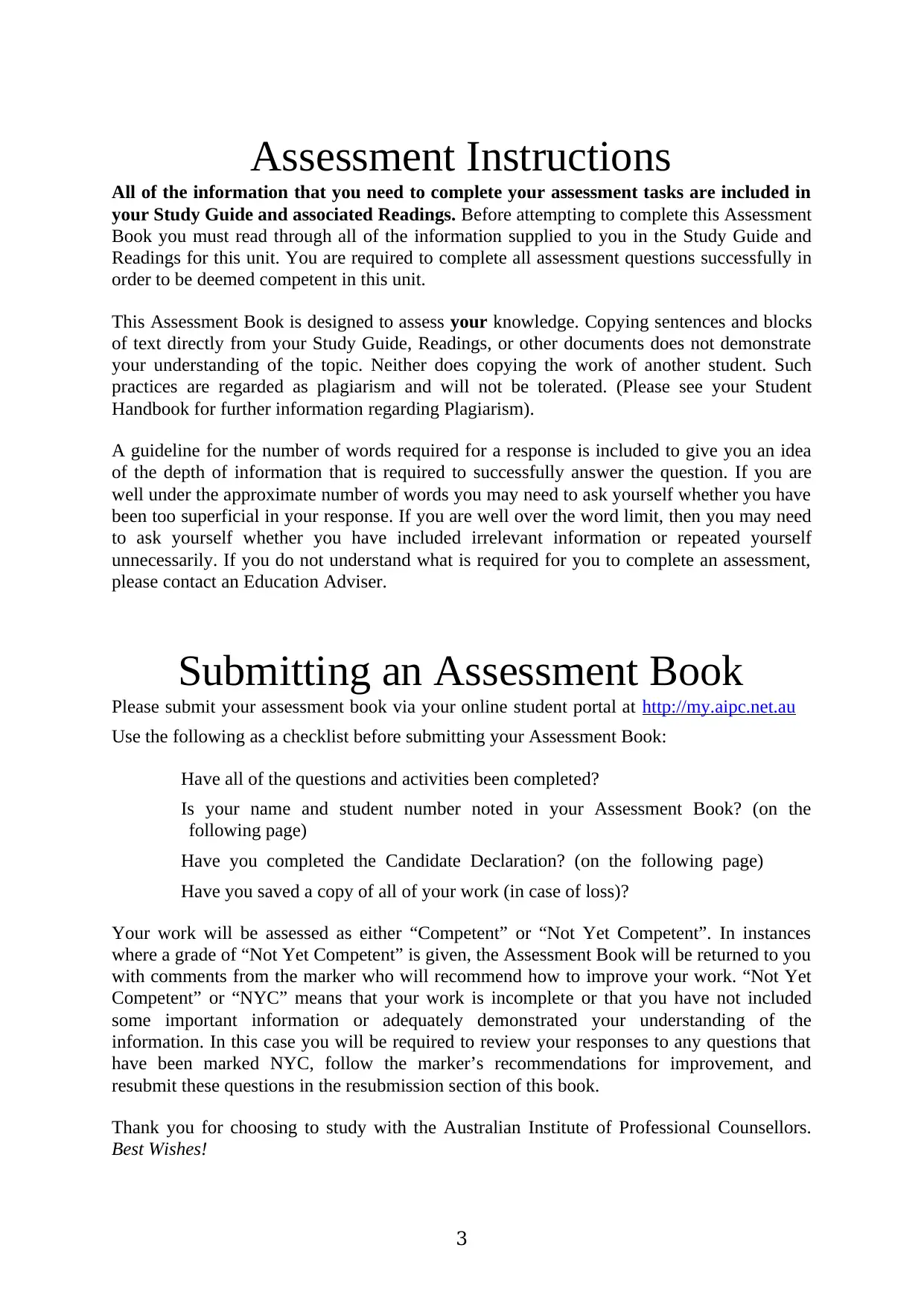
Assessment Instructions
All of the information that you need to complete your assessment tasks are included in
your Study Guide and associated Readings. Before attempting to complete this Assessment
Book you must read through all of the information supplied to you in the Study Guide and
Readings for this unit. You are required to complete all assessment questions successfully in
order to be deemed competent in this unit.
This Assessment Book is designed to assess your knowledge. Copying sentences and blocks
of text directly from your Study Guide, Readings, or other documents does not demonstrate
your understanding of the topic. Neither does copying the work of another student. Such
practices are regarded as plagiarism and will not be tolerated. (Please see your Student
Handbook for further information regarding Plagiarism).
A guideline for the number of words required for a response is included to give you an idea
of the depth of information that is required to successfully answer the question. If you are
well under the approximate number of words you may need to ask yourself whether you have
been too superficial in your response. If you are well over the word limit, then you may need
to ask yourself whether you have included irrelevant information or repeated yourself
unnecessarily. If you do not understand what is required for you to complete an assessment,
please contact an Education Adviser.
Submitting an Assessment Book
Please submit your assessment book via your online student portal at http://my.aipc.net.au
Use the following as a checklist before submitting your Assessment Book:
Have all of the questions and activities been completed?
Is your name and student number noted in your Assessment Book? (on the
following page)
Have you completed the Candidate Declaration? (on the following page)
Have you saved a copy of all of your work (in case of loss)?
Your work will be assessed as either “Competent” or “Not Yet Competent”. In instances
where a grade of “Not Yet Competent” is given, the Assessment Book will be returned to you
with comments from the marker who will recommend how to improve your work. “Not Yet
Competent” or “NYC” means that your work is incomplete or that you have not included
some important information or adequately demonstrated your understanding of the
information. In this case you will be required to review your responses to any questions that
have been marked NYC, follow the marker’s recommendations for improvement, and
resubmit these questions in the resubmission section of this book.
Thank you for choosing to study with the Australian Institute of Professional Counsellors.
Best Wishes!
3
All of the information that you need to complete your assessment tasks are included in
your Study Guide and associated Readings. Before attempting to complete this Assessment
Book you must read through all of the information supplied to you in the Study Guide and
Readings for this unit. You are required to complete all assessment questions successfully in
order to be deemed competent in this unit.
This Assessment Book is designed to assess your knowledge. Copying sentences and blocks
of text directly from your Study Guide, Readings, or other documents does not demonstrate
your understanding of the topic. Neither does copying the work of another student. Such
practices are regarded as plagiarism and will not be tolerated. (Please see your Student
Handbook for further information regarding Plagiarism).
A guideline for the number of words required for a response is included to give you an idea
of the depth of information that is required to successfully answer the question. If you are
well under the approximate number of words you may need to ask yourself whether you have
been too superficial in your response. If you are well over the word limit, then you may need
to ask yourself whether you have included irrelevant information or repeated yourself
unnecessarily. If you do not understand what is required for you to complete an assessment,
please contact an Education Adviser.
Submitting an Assessment Book
Please submit your assessment book via your online student portal at http://my.aipc.net.au
Use the following as a checklist before submitting your Assessment Book:
Have all of the questions and activities been completed?
Is your name and student number noted in your Assessment Book? (on the
following page)
Have you completed the Candidate Declaration? (on the following page)
Have you saved a copy of all of your work (in case of loss)?
Your work will be assessed as either “Competent” or “Not Yet Competent”. In instances
where a grade of “Not Yet Competent” is given, the Assessment Book will be returned to you
with comments from the marker who will recommend how to improve your work. “Not Yet
Competent” or “NYC” means that your work is incomplete or that you have not included
some important information or adequately demonstrated your understanding of the
information. In this case you will be required to review your responses to any questions that
have been marked NYC, follow the marker’s recommendations for improvement, and
resubmit these questions in the resubmission section of this book.
Thank you for choosing to study with the Australian Institute of Professional Counsellors.
Best Wishes!
3
⊘ This is a preview!⊘
Do you want full access?
Subscribe today to unlock all pages.

Trusted by 1+ million students worldwide
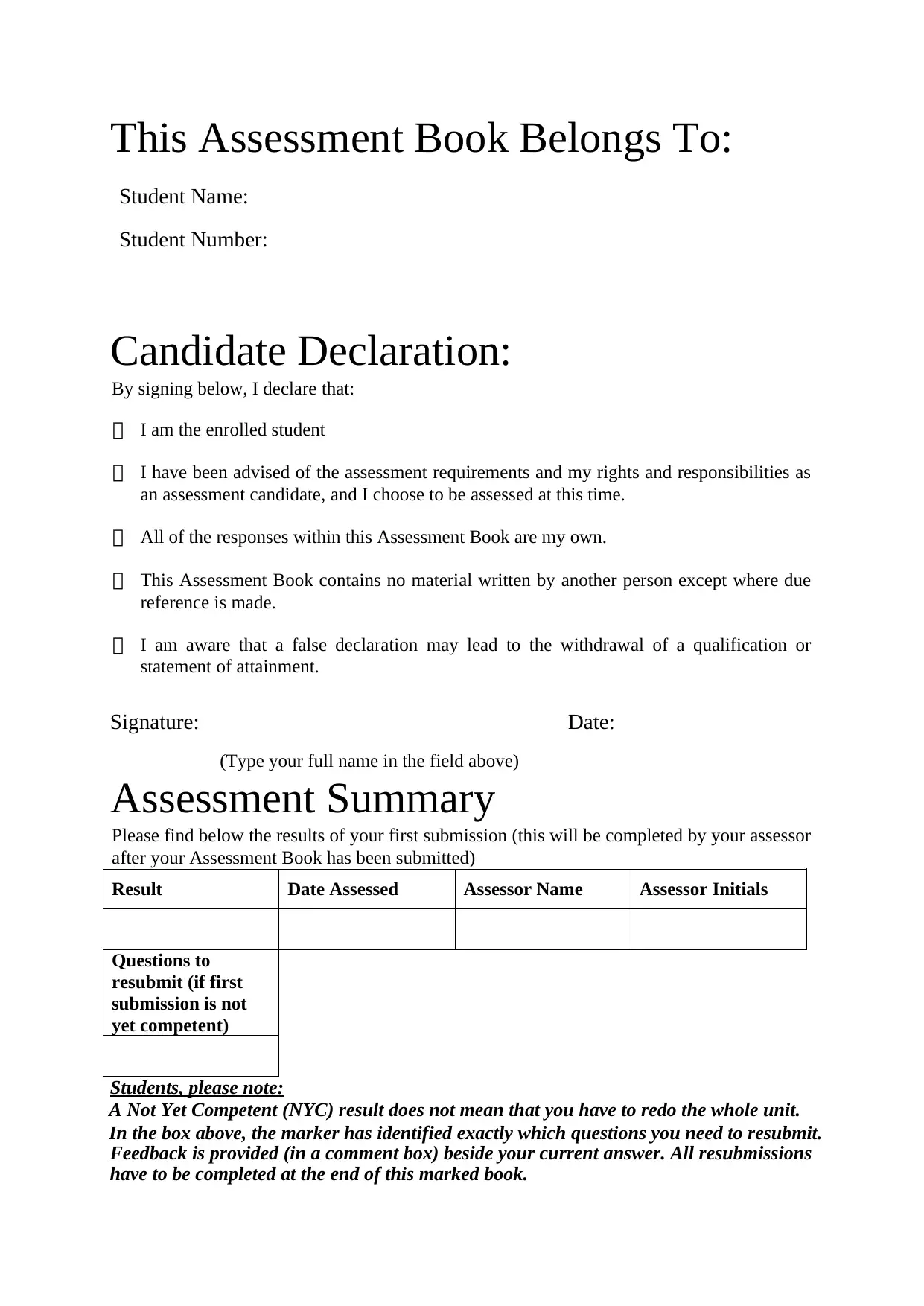
This Assessment Book Belongs To:
Student Name:
Student Number:
Candidate Declaration:
By signing below, I declare that:
I am the enrolled student
I have been advised of the assessment requirements and my rights and responsibilities as
an assessment candidate, and I choose to be assessed at this time.
All of the responses within this Assessment Book are my own.
This Assessment Book contains no material written by another person except where due
reference is made.
I am aware that a false declaration may lead to the withdrawal of a qualification or
statement of attainment.
Signature: Date:
(Type your full name in the field above)
Assessment Summary
Please find below the results of your first submission (this will be completed by your assessor
after your Assessment Book has been submitted)
Result Date Assessed Assessor Name Assessor Initials
Questions to
resubmit (if first
submission is not
yet competent)
Students, please note:
A Not Yet Competent (NYC) result does not mean that you have to redo the whole unit.
In the box above, the marker has identified exactly which questions you need to resubmit.
Feedback is provided (in a comment box) beside your current answer. All resubmissions
have to be completed at the end of this marked book.
Student Name:
Student Number:
Candidate Declaration:
By signing below, I declare that:
I am the enrolled student
I have been advised of the assessment requirements and my rights and responsibilities as
an assessment candidate, and I choose to be assessed at this time.
All of the responses within this Assessment Book are my own.
This Assessment Book contains no material written by another person except where due
reference is made.
I am aware that a false declaration may lead to the withdrawal of a qualification or
statement of attainment.
Signature: Date:
(Type your full name in the field above)
Assessment Summary
Please find below the results of your first submission (this will be completed by your assessor
after your Assessment Book has been submitted)
Result Date Assessed Assessor Name Assessor Initials
Questions to
resubmit (if first
submission is not
yet competent)
Students, please note:
A Not Yet Competent (NYC) result does not mean that you have to redo the whole unit.
In the box above, the marker has identified exactly which questions you need to resubmit.
Feedback is provided (in a comment box) beside your current answer. All resubmissions
have to be completed at the end of this marked book.
Paraphrase This Document
Need a fresh take? Get an instant paraphrase of this document with our AI Paraphraser
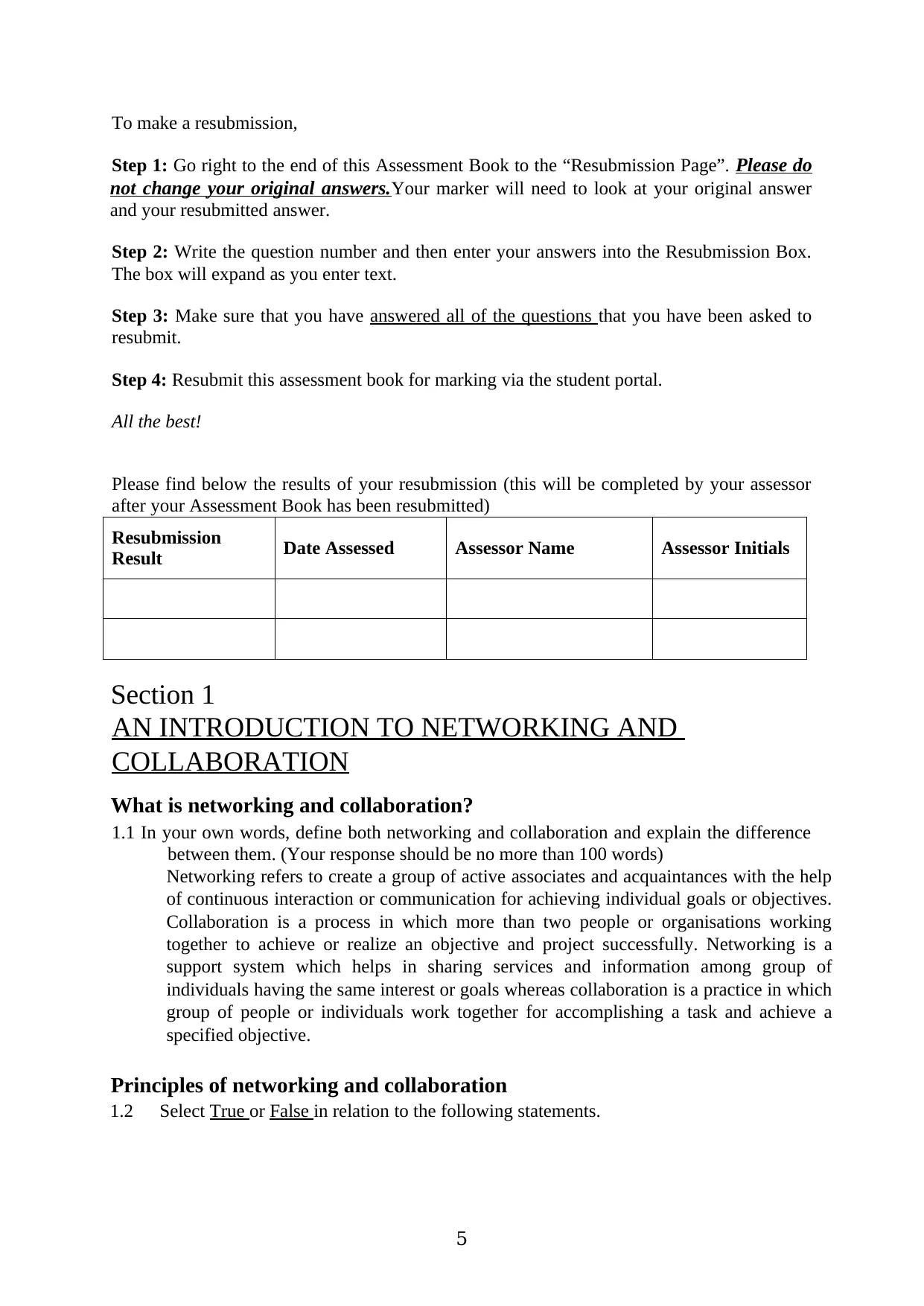
To make a resubmission,
Step 1: Go right to the end of this Assessment Book to the “Resubmission Page”. Please do
not change your original answers.Your marker will need to look at your original answer
and your resubmitted answer.
Step 2: Write the question number and then enter your answers into the Resubmission Box.
The box will expand as you enter text.
Step 3: Make sure that you have answered all of the questions that you have been asked to
resubmit.
Step 4: Resubmit this assessment book for marking via the student portal.
All the best!
Please find below the results of your resubmission (this will be completed by your assessor
after your Assessment Book has been resubmitted)
Resubmission
Result Date Assessed Assessor Name Assessor Initials
Section 1
AN INTRODUCTION TO NETWORKING AND
COLLABORATION
What is networking and collaboration?
1.1 In your own words, define both networking and collaboration and explain the difference
between them. (Your response should be no more than 100 words)
Networking refers to create a group of active associates and acquaintances with the help
of continuous interaction or communication for achieving individual goals or objectives.
Collaboration is a process in which more than two people or organisations working
together to achieve or realize an objective and project successfully. Networking is a
support system which helps in sharing services and information among group of
individuals having the same interest or goals whereas collaboration is a practice in which
group of people or individuals work together for accomplishing a task and achieve a
specified objective.
Principles of networking and collaboration
1.2 Select True or False in relation to the following statements.
5
Step 1: Go right to the end of this Assessment Book to the “Resubmission Page”. Please do
not change your original answers.Your marker will need to look at your original answer
and your resubmitted answer.
Step 2: Write the question number and then enter your answers into the Resubmission Box.
The box will expand as you enter text.
Step 3: Make sure that you have answered all of the questions that you have been asked to
resubmit.
Step 4: Resubmit this assessment book for marking via the student portal.
All the best!
Please find below the results of your resubmission (this will be completed by your assessor
after your Assessment Book has been resubmitted)
Resubmission
Result Date Assessed Assessor Name Assessor Initials
Section 1
AN INTRODUCTION TO NETWORKING AND
COLLABORATION
What is networking and collaboration?
1.1 In your own words, define both networking and collaboration and explain the difference
between them. (Your response should be no more than 100 words)
Networking refers to create a group of active associates and acquaintances with the help
of continuous interaction or communication for achieving individual goals or objectives.
Collaboration is a process in which more than two people or organisations working
together to achieve or realize an objective and project successfully. Networking is a
support system which helps in sharing services and information among group of
individuals having the same interest or goals whereas collaboration is a practice in which
group of people or individuals work together for accomplishing a task and achieve a
specified objective.
Principles of networking and collaboration
1.2 Select True or False in relation to the following statements.
5
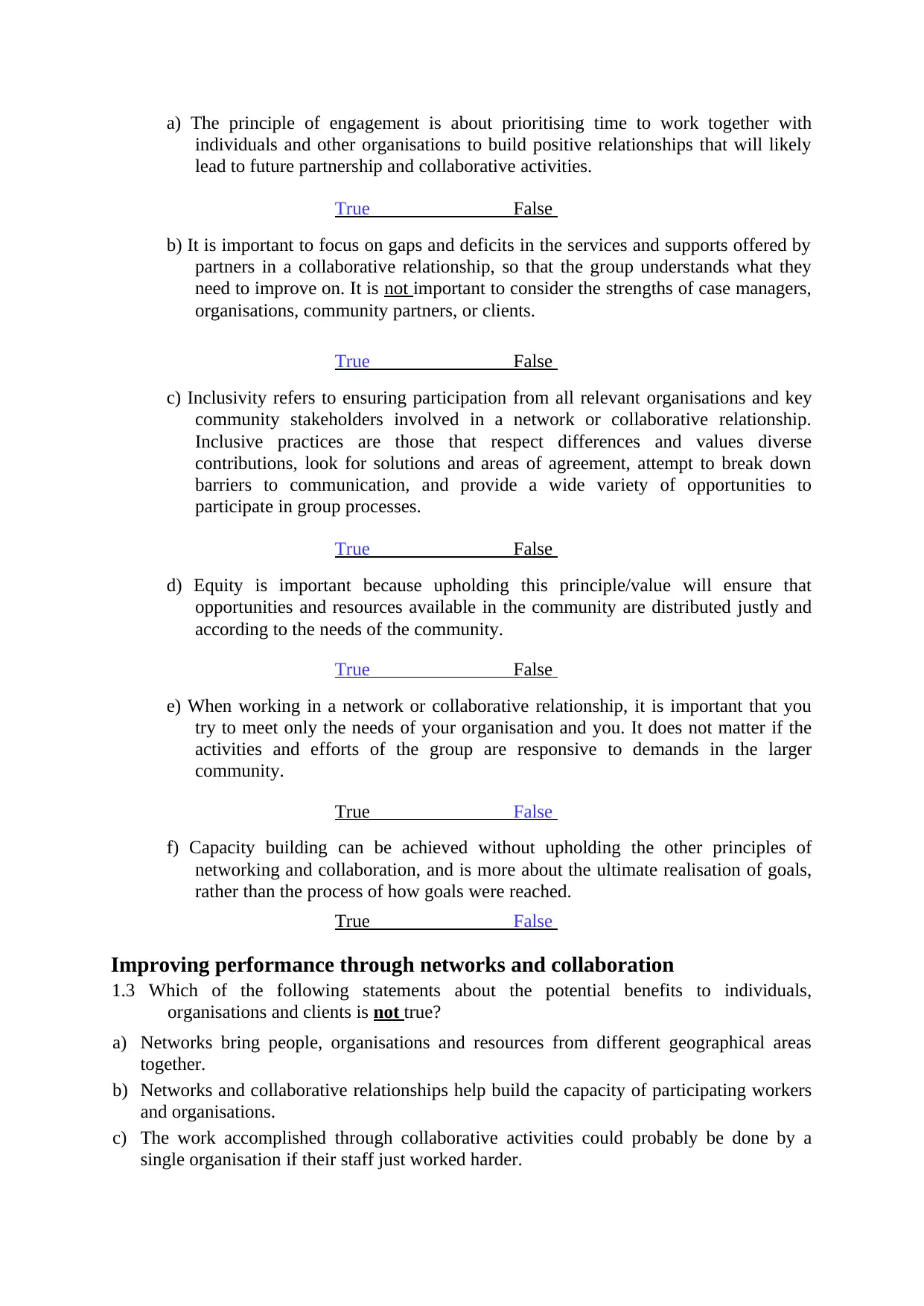
a) The principle of engagement is about prioritising time to work together with
individuals and other organisations to build positive relationships that will likely
lead to future partnership and collaborative activities.
True False
b) It is important to focus on gaps and deficits in the services and supports offered by
partners in a collaborative relationship, so that the group understands what they
need to improve on. It is not important to consider the strengths of case managers,
organisations, community partners, or clients.
True False
c) Inclusivity refers to ensuring participation from all relevant organisations and key
community stakeholders involved in a network or collaborative relationship.
Inclusive practices are those that respect differences and values diverse
contributions, look for solutions and areas of agreement, attempt to break down
barriers to communication, and provide a wide variety of opportunities to
participate in group processes.
True False
d) Equity is important because upholding this principle/value will ensure that
opportunities and resources available in the community are distributed justly and
according to the needs of the community.
True False
e) When working in a network or collaborative relationship, it is important that you
try to meet only the needs of your organisation and you. It does not matter if the
activities and efforts of the group are responsive to demands in the larger
community.
True False
f) Capacity building can be achieved without upholding the other principles of
networking and collaboration, and is more about the ultimate realisation of goals,
rather than the process of how goals were reached.
True False
Improving performance through networks and collaboration
1.3 Which of the following statements about the potential benefits to individuals,
organisations and clients is not true?
a) Networks bring people, organisations and resources from different geographical areas
together.
b) Networks and collaborative relationships help build the capacity of participating workers
and organisations.
c) The work accomplished through collaborative activities could probably be done by a
single organisation if their staff just worked harder.
individuals and other organisations to build positive relationships that will likely
lead to future partnership and collaborative activities.
True False
b) It is important to focus on gaps and deficits in the services and supports offered by
partners in a collaborative relationship, so that the group understands what they
need to improve on. It is not important to consider the strengths of case managers,
organisations, community partners, or clients.
True False
c) Inclusivity refers to ensuring participation from all relevant organisations and key
community stakeholders involved in a network or collaborative relationship.
Inclusive practices are those that respect differences and values diverse
contributions, look for solutions and areas of agreement, attempt to break down
barriers to communication, and provide a wide variety of opportunities to
participate in group processes.
True False
d) Equity is important because upholding this principle/value will ensure that
opportunities and resources available in the community are distributed justly and
according to the needs of the community.
True False
e) When working in a network or collaborative relationship, it is important that you
try to meet only the needs of your organisation and you. It does not matter if the
activities and efforts of the group are responsive to demands in the larger
community.
True False
f) Capacity building can be achieved without upholding the other principles of
networking and collaboration, and is more about the ultimate realisation of goals,
rather than the process of how goals were reached.
True False
Improving performance through networks and collaboration
1.3 Which of the following statements about the potential benefits to individuals,
organisations and clients is not true?
a) Networks bring people, organisations and resources from different geographical areas
together.
b) Networks and collaborative relationships help build the capacity of participating workers
and organisations.
c) The work accomplished through collaborative activities could probably be done by a
single organisation if their staff just worked harder.
⊘ This is a preview!⊘
Do you want full access?
Subscribe today to unlock all pages.

Trusted by 1+ million students worldwide
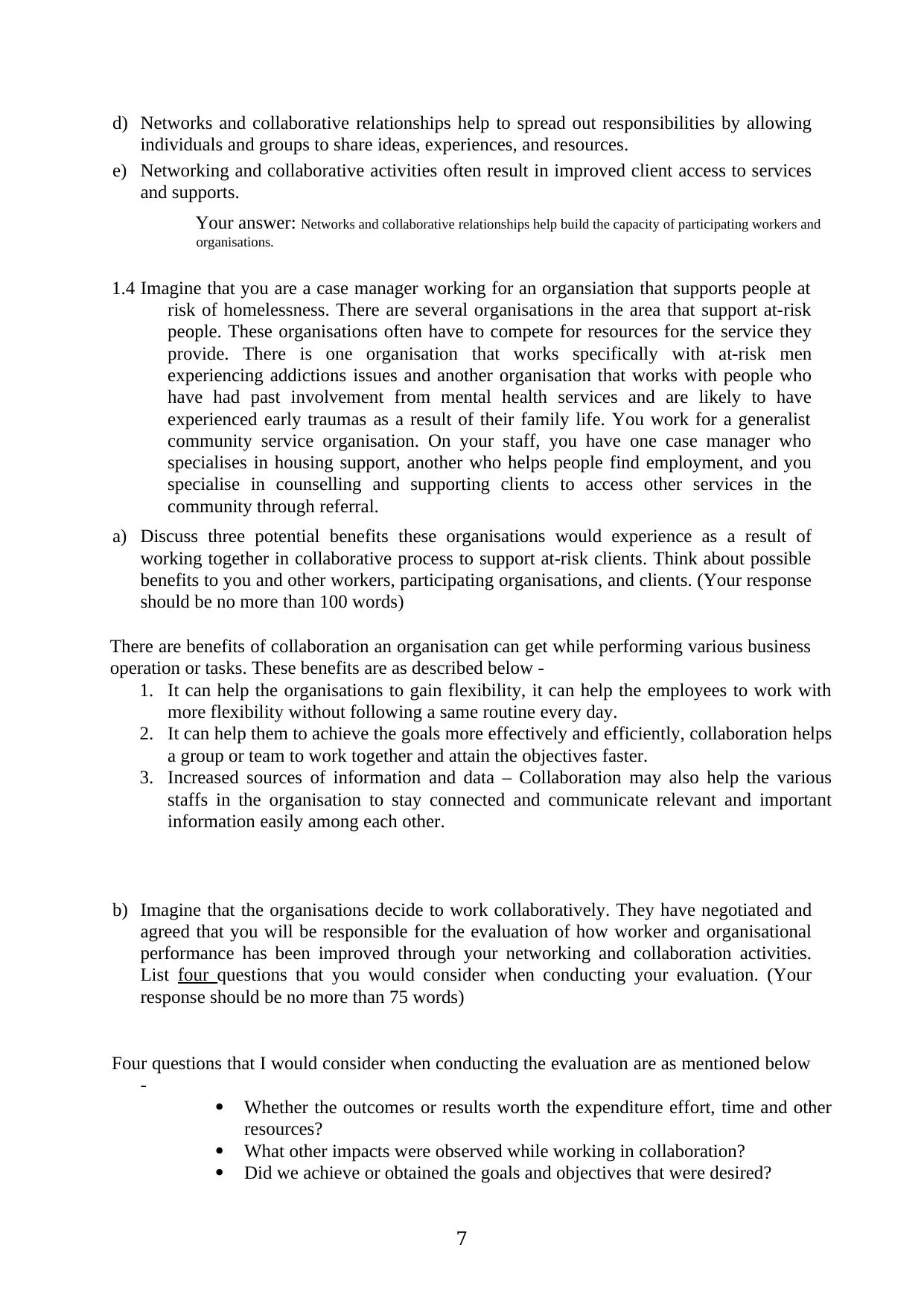
d) Networks and collaborative relationships help to spread out responsibilities by allowing
individuals and groups to share ideas, experiences, and resources.
e) Networking and collaborative activities often result in improved client access to services
and supports.
Your answer: Networks and collaborative relationships help build the capacity of participating workers and
organisations.
1.4 Imagine that you are a case manager working for an organsiation that supports people at
risk of homelessness. There are several organisations in the area that support at-risk
people. These organisations often have to compete for resources for the service they
provide. There is one organisation that works specifically with at-risk men
experiencing addictions issues and another organisation that works with people who
have had past involvement from mental health services and are likely to have
experienced early traumas as a result of their family life. You work for a generalist
community service organisation. On your staff, you have one case manager who
specialises in housing support, another who helps people find employment, and you
specialise in counselling and supporting clients to access other services in the
community through referral.
a) Discuss three potential benefits these organisations would experience as a result of
working together in collaborative process to support at-risk clients. Think about possible
benefits to you and other workers, participating organisations, and clients. (Your response
should be no more than 100 words)
There are benefits of collaboration an organisation can get while performing various business
operation or tasks. These benefits are as described below -
1. It can help the organisations to gain flexibility, it can help the employees to work with
more flexibility without following a same routine every day.
2. It can help them to achieve the goals more effectively and efficiently, collaboration helps
a group or team to work together and attain the objectives faster.
3. Increased sources of information and data – Collaboration may also help the various
staffs in the organisation to stay connected and communicate relevant and important
information easily among each other.
b) Imagine that the organisations decide to work collaboratively. They have negotiated and
agreed that you will be responsible for the evaluation of how worker and organisational
performance has been improved through your networking and collaboration activities.
List four questions that you would consider when conducting your evaluation. (Your
response should be no more than 75 words)
Four questions that I would consider when conducting the evaluation are as mentioned below
-
Whether the outcomes or results worth the expenditure effort, time and other
resources?
What other impacts were observed while working in collaboration?
Did we achieve or obtained the goals and objectives that were desired?
7
individuals and groups to share ideas, experiences, and resources.
e) Networking and collaborative activities often result in improved client access to services
and supports.
Your answer: Networks and collaborative relationships help build the capacity of participating workers and
organisations.
1.4 Imagine that you are a case manager working for an organsiation that supports people at
risk of homelessness. There are several organisations in the area that support at-risk
people. These organisations often have to compete for resources for the service they
provide. There is one organisation that works specifically with at-risk men
experiencing addictions issues and another organisation that works with people who
have had past involvement from mental health services and are likely to have
experienced early traumas as a result of their family life. You work for a generalist
community service organisation. On your staff, you have one case manager who
specialises in housing support, another who helps people find employment, and you
specialise in counselling and supporting clients to access other services in the
community through referral.
a) Discuss three potential benefits these organisations would experience as a result of
working together in collaborative process to support at-risk clients. Think about possible
benefits to you and other workers, participating organisations, and clients. (Your response
should be no more than 100 words)
There are benefits of collaboration an organisation can get while performing various business
operation or tasks. These benefits are as described below -
1. It can help the organisations to gain flexibility, it can help the employees to work with
more flexibility without following a same routine every day.
2. It can help them to achieve the goals more effectively and efficiently, collaboration helps
a group or team to work together and attain the objectives faster.
3. Increased sources of information and data – Collaboration may also help the various
staffs in the organisation to stay connected and communicate relevant and important
information easily among each other.
b) Imagine that the organisations decide to work collaboratively. They have negotiated and
agreed that you will be responsible for the evaluation of how worker and organisational
performance has been improved through your networking and collaboration activities.
List four questions that you would consider when conducting your evaluation. (Your
response should be no more than 75 words)
Four questions that I would consider when conducting the evaluation are as mentioned below
-
Whether the outcomes or results worth the expenditure effort, time and other
resources?
What other impacts were observed while working in collaboration?
Did we achieve or obtained the goals and objectives that were desired?
7
Paraphrase This Document
Need a fresh take? Get an instant paraphrase of this document with our AI Paraphraser
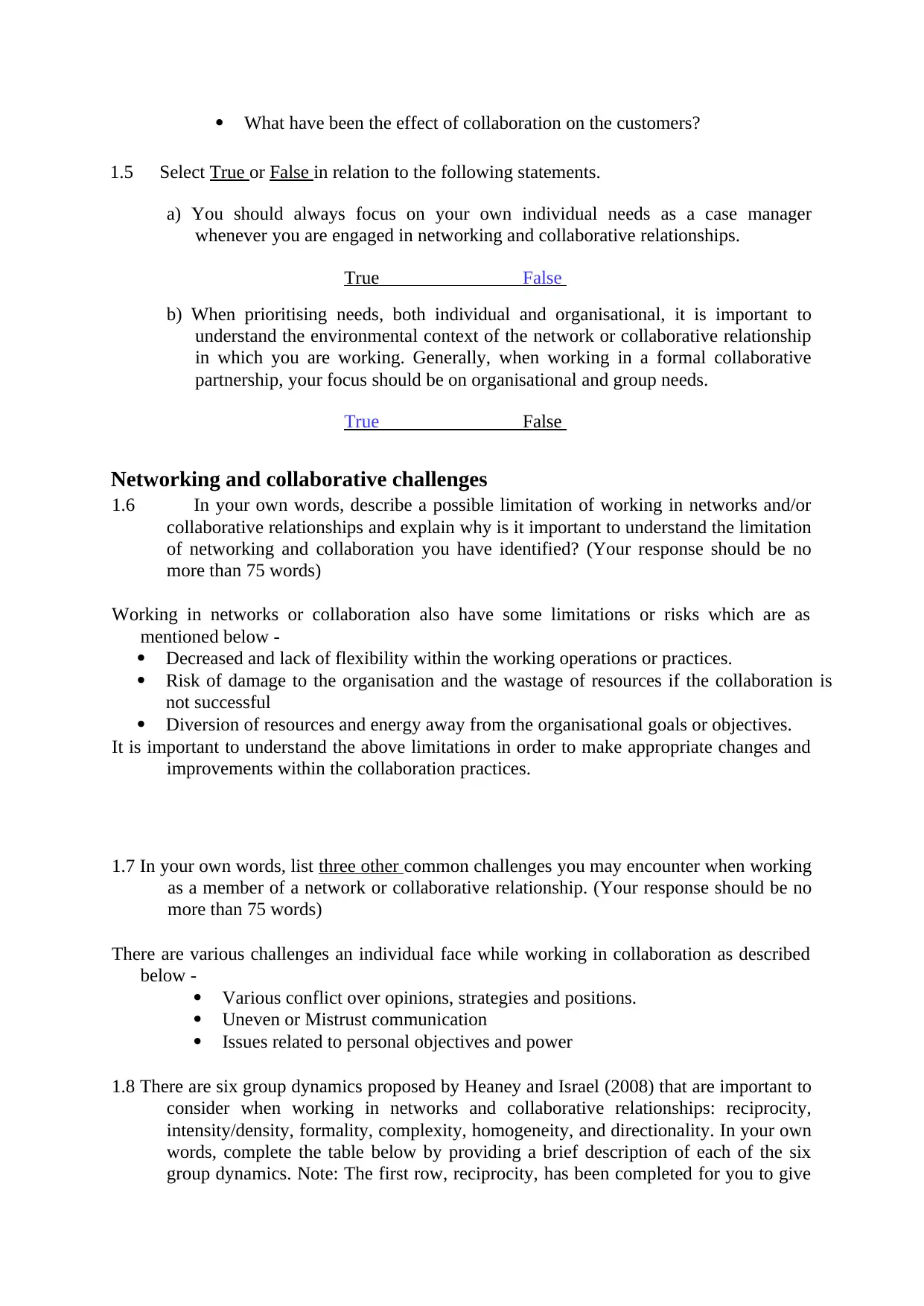
What have been the effect of collaboration on the customers?
1.5 Select True or False in relation to the following statements.
a) You should always focus on your own individual needs as a case manager
whenever you are engaged in networking and collaborative relationships.
True False
b) When prioritising needs, both individual and organisational, it is important to
understand the environmental context of the network or collaborative relationship
in which you are working. Generally, when working in a formal collaborative
partnership, your focus should be on organisational and group needs.
True False
Networking and collaborative challenges
1.6 In your own words, describe a possible limitation of working in networks and/or
collaborative relationships and explain why is it important to understand the limitation
of networking and collaboration you have identified? (Your response should be no
more than 75 words)
Working in networks or collaboration also have some limitations or risks which are as
mentioned below -
Decreased and lack of flexibility within the working operations or practices.
Risk of damage to the organisation and the wastage of resources if the collaboration is
not successful
Diversion of resources and energy away from the organisational goals or objectives.
It is important to understand the above limitations in order to make appropriate changes and
improvements within the collaboration practices.
1.7 In your own words, list three other common challenges you may encounter when working
as a member of a network or collaborative relationship. (Your response should be no
more than 75 words)
There are various challenges an individual face while working in collaboration as described
below -
Various conflict over opinions, strategies and positions.
Uneven or Mistrust communication
Issues related to personal objectives and power
1.8 There are six group dynamics proposed by Heaney and Israel (2008) that are important to
consider when working in networks and collaborative relationships: reciprocity,
intensity/density, formality, complexity, homogeneity, and directionality. In your own
words, complete the table below by providing a brief description of each of the six
group dynamics. Note: The first row, reciprocity, has been completed for you to give
1.5 Select True or False in relation to the following statements.
a) You should always focus on your own individual needs as a case manager
whenever you are engaged in networking and collaborative relationships.
True False
b) When prioritising needs, both individual and organisational, it is important to
understand the environmental context of the network or collaborative relationship
in which you are working. Generally, when working in a formal collaborative
partnership, your focus should be on organisational and group needs.
True False
Networking and collaborative challenges
1.6 In your own words, describe a possible limitation of working in networks and/or
collaborative relationships and explain why is it important to understand the limitation
of networking and collaboration you have identified? (Your response should be no
more than 75 words)
Working in networks or collaboration also have some limitations or risks which are as
mentioned below -
Decreased and lack of flexibility within the working operations or practices.
Risk of damage to the organisation and the wastage of resources if the collaboration is
not successful
Diversion of resources and energy away from the organisational goals or objectives.
It is important to understand the above limitations in order to make appropriate changes and
improvements within the collaboration practices.
1.7 In your own words, list three other common challenges you may encounter when working
as a member of a network or collaborative relationship. (Your response should be no
more than 75 words)
There are various challenges an individual face while working in collaboration as described
below -
Various conflict over opinions, strategies and positions.
Uneven or Mistrust communication
Issues related to personal objectives and power
1.8 There are six group dynamics proposed by Heaney and Israel (2008) that are important to
consider when working in networks and collaborative relationships: reciprocity,
intensity/density, formality, complexity, homogeneity, and directionality. In your own
words, complete the table below by providing a brief description of each of the six
group dynamics. Note: The first row, reciprocity, has been completed for you to give
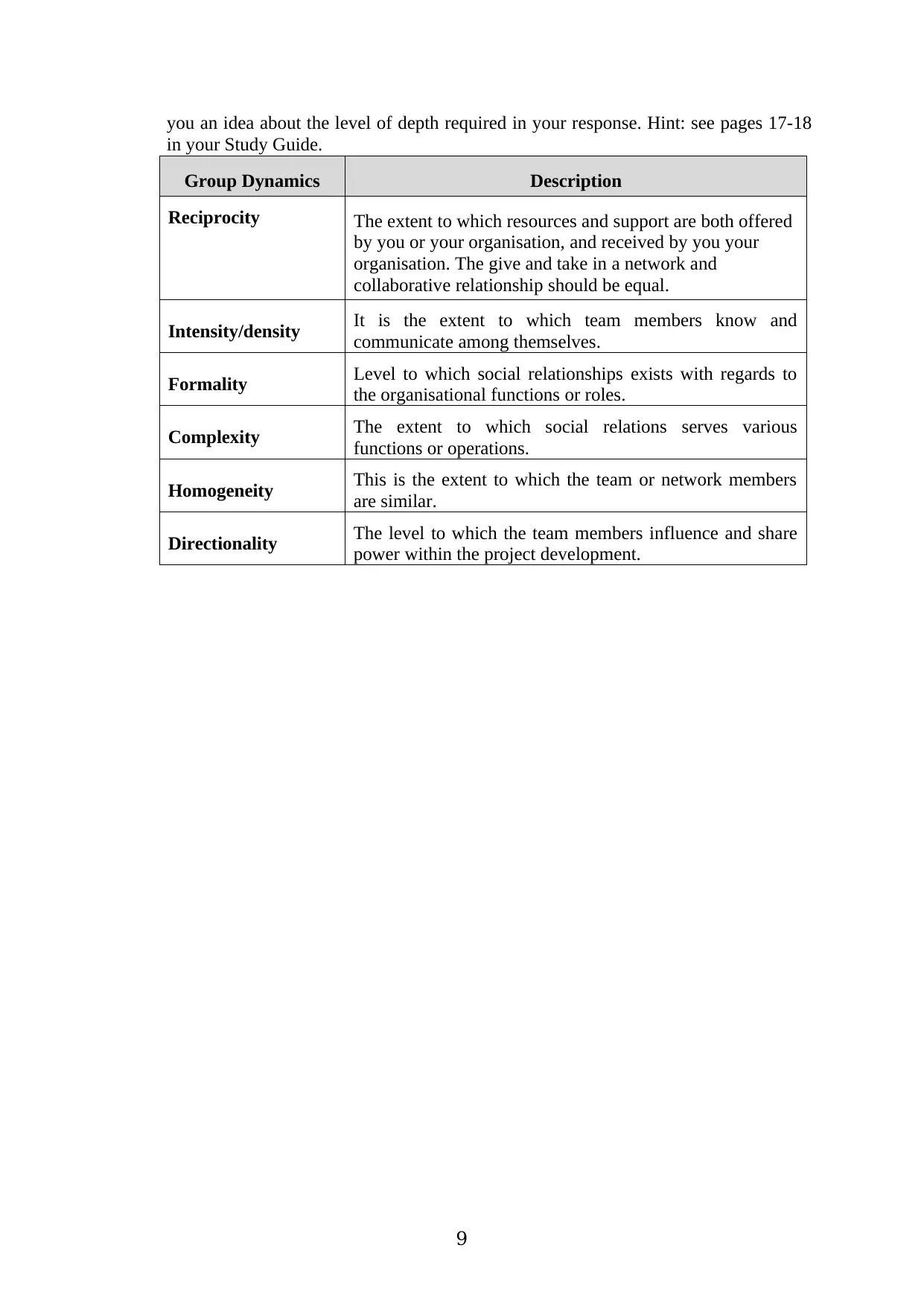
you an idea about the level of depth required in your response. Hint: see pages 17-18
in your Study Guide.
Group Dynamics Description
Reciprocity The extent to which resources and support are both offered
by you or your organisation, and received by you your
organisation. The give and take in a network and
collaborative relationship should be equal.
Intensity/density It is the extent to which team members know and
communicate among themselves.
Formality Level to which social relationships exists with regards to
the organisational functions or roles.
Complexity The extent to which social relations serves various
functions or operations.
Homogeneity This is the extent to which the team or network members
are similar.
Directionality The level to which the team members influence and share
power within the project development.
9
in your Study Guide.
Group Dynamics Description
Reciprocity The extent to which resources and support are both offered
by you or your organisation, and received by you your
organisation. The give and take in a network and
collaborative relationship should be equal.
Intensity/density It is the extent to which team members know and
communicate among themselves.
Formality Level to which social relationships exists with regards to
the organisational functions or roles.
Complexity The extent to which social relations serves various
functions or operations.
Homogeneity This is the extent to which the team or network members
are similar.
Directionality The level to which the team members influence and share
power within the project development.
9
⊘ This is a preview!⊘
Do you want full access?
Subscribe today to unlock all pages.

Trusted by 1+ million students worldwide
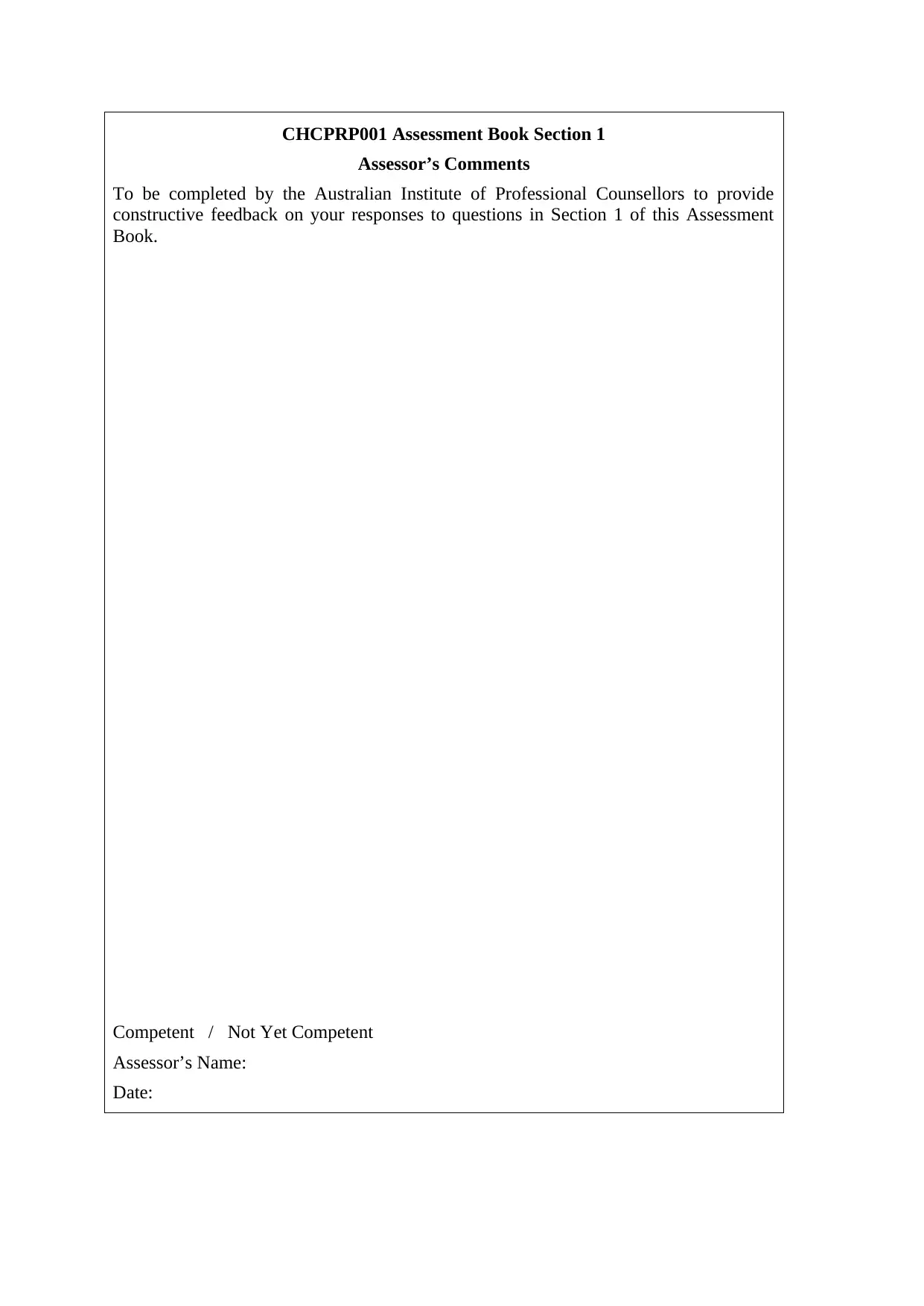
CHCPRP001 Assessment Book Section 1
Assessor’s Comments
To be completed by the Australian Institute of Professional Counsellors to provide
constructive feedback on your responses to questions in Section 1 of this Assessment
Book.
Competent / Not Yet Competent
Assessor’s Name:
Date:
Assessor’s Comments
To be completed by the Australian Institute of Professional Counsellors to provide
constructive feedback on your responses to questions in Section 1 of this Assessment
Book.
Competent / Not Yet Competent
Assessor’s Name:
Date:
Paraphrase This Document
Need a fresh take? Get an instant paraphrase of this document with our AI Paraphraser
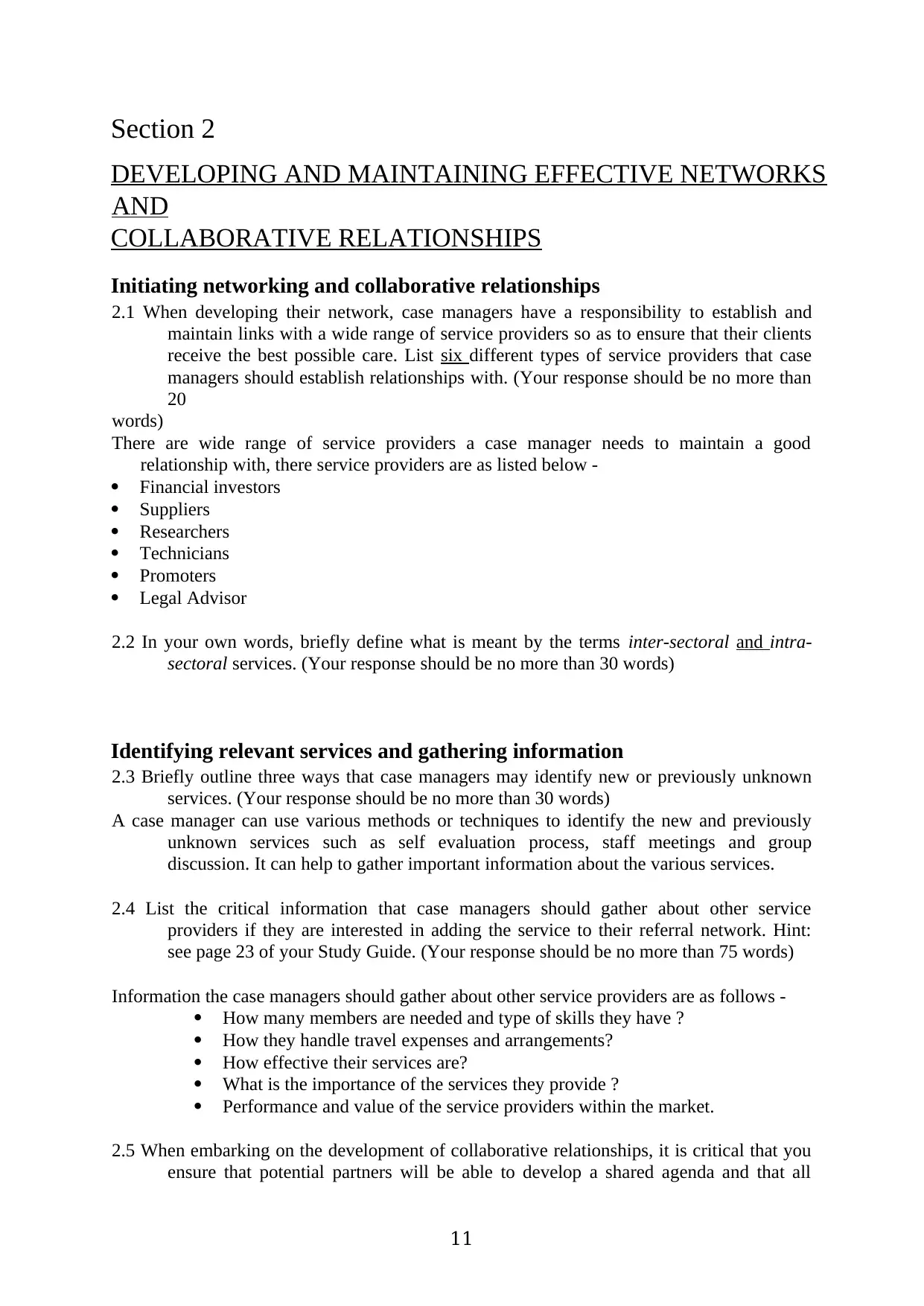
Section 2
DEVELOPING AND MAINTAINING EFFECTIVE NETWORKS
AND
COLLABORATIVE RELATIONSHIPS
Initiating networking and collaborative relationships
2.1 When developing their network, case managers have a responsibility to establish and
maintain links with a wide range of service providers so as to ensure that their clients
receive the best possible care. List six different types of service providers that case
managers should establish relationships with. (Your response should be no more than
20
words)
There are wide range of service providers a case manager needs to maintain a good
relationship with, there service providers are as listed below -
Financial investors
Suppliers
Researchers
Technicians
Promoters
Legal Advisor
2.2 In your own words, briefly define what is meant by the terms inter-sectoral and intra-
sectoral services. (Your response should be no more than 30 words)
Identifying relevant services and gathering information
2.3 Briefly outline three ways that case managers may identify new or previously unknown
services. (Your response should be no more than 30 words)
A case manager can use various methods or techniques to identify the new and previously
unknown services such as self evaluation process, staff meetings and group
discussion. It can help to gather important information about the various services.
2.4 List the critical information that case managers should gather about other service
providers if they are interested in adding the service to their referral network. Hint:
see page 23 of your Study Guide. (Your response should be no more than 75 words)
Information the case managers should gather about other service providers are as follows -
How many members are needed and type of skills they have ?
How they handle travel expenses and arrangements?
How effective their services are?
What is the importance of the services they provide ?
Performance and value of the service providers within the market.
2.5 When embarking on the development of collaborative relationships, it is critical that you
ensure that potential partners will be able to develop a shared agenda and that all
11
DEVELOPING AND MAINTAINING EFFECTIVE NETWORKS
AND
COLLABORATIVE RELATIONSHIPS
Initiating networking and collaborative relationships
2.1 When developing their network, case managers have a responsibility to establish and
maintain links with a wide range of service providers so as to ensure that their clients
receive the best possible care. List six different types of service providers that case
managers should establish relationships with. (Your response should be no more than
20
words)
There are wide range of service providers a case manager needs to maintain a good
relationship with, there service providers are as listed below -
Financial investors
Suppliers
Researchers
Technicians
Promoters
Legal Advisor
2.2 In your own words, briefly define what is meant by the terms inter-sectoral and intra-
sectoral services. (Your response should be no more than 30 words)
Identifying relevant services and gathering information
2.3 Briefly outline three ways that case managers may identify new or previously unknown
services. (Your response should be no more than 30 words)
A case manager can use various methods or techniques to identify the new and previously
unknown services such as self evaluation process, staff meetings and group
discussion. It can help to gather important information about the various services.
2.4 List the critical information that case managers should gather about other service
providers if they are interested in adding the service to their referral network. Hint:
see page 23 of your Study Guide. (Your response should be no more than 75 words)
Information the case managers should gather about other service providers are as follows -
How many members are needed and type of skills they have ?
How they handle travel expenses and arrangements?
How effective their services are?
What is the importance of the services they provide ?
Performance and value of the service providers within the market.
2.5 When embarking on the development of collaborative relationships, it is critical that you
ensure that potential partners will be able to develop a shared agenda and that all
11
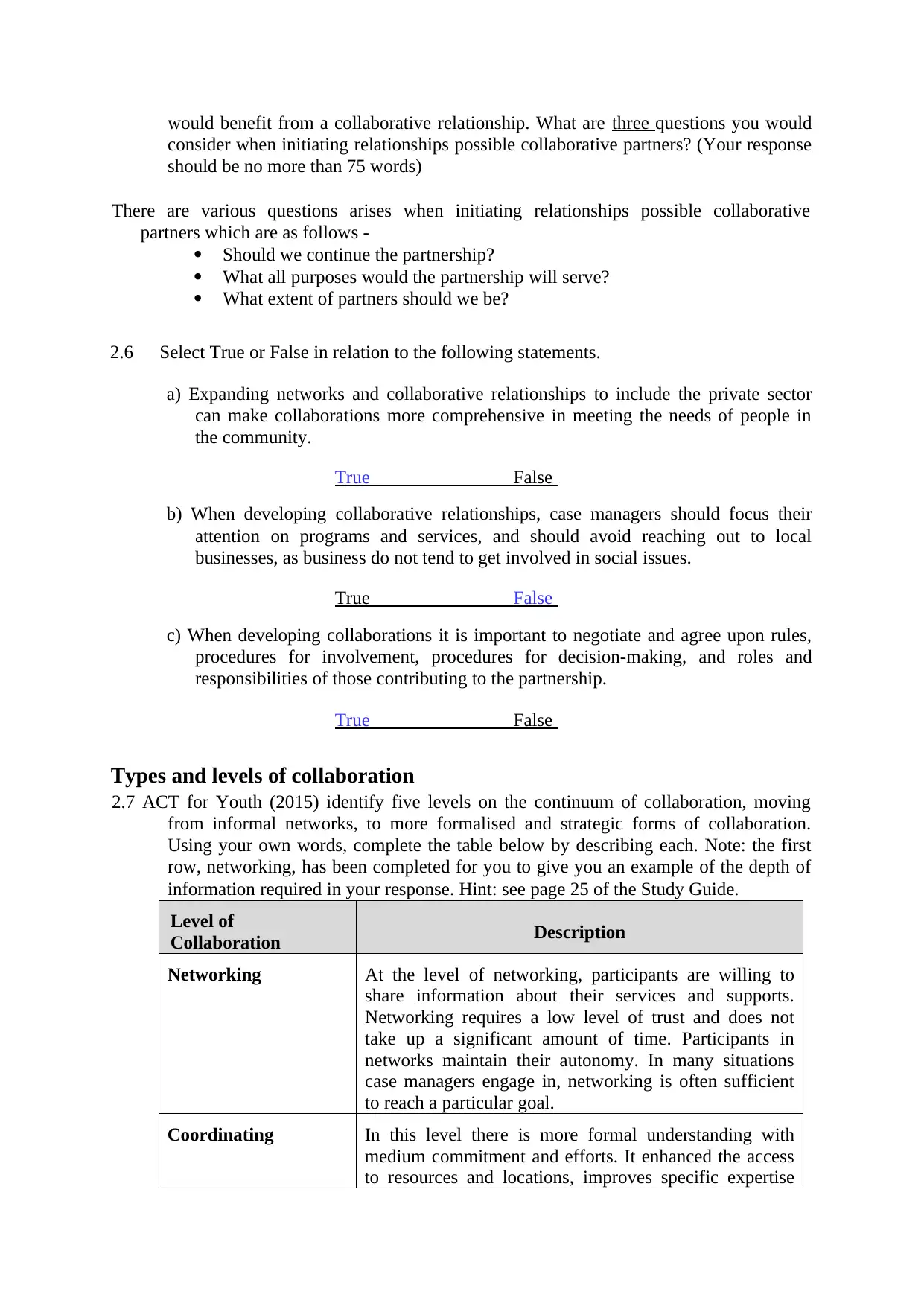
would benefit from a collaborative relationship. What are three questions you would
consider when initiating relationships possible collaborative partners? (Your response
should be no more than 75 words)
There are various questions arises when initiating relationships possible collaborative
partners which are as follows -
Should we continue the partnership?
What all purposes would the partnership will serve?
What extent of partners should we be?
2.6 Select True or False in relation to the following statements.
a) Expanding networks and collaborative relationships to include the private sector
can make collaborations more comprehensive in meeting the needs of people in
the community.
True False
b) When developing collaborative relationships, case managers should focus their
attention on programs and services, and should avoid reaching out to local
businesses, as business do not tend to get involved in social issues.
True False
c) When developing collaborations it is important to negotiate and agree upon rules,
procedures for involvement, procedures for decision-making, and roles and
responsibilities of those contributing to the partnership.
True False
Types and levels of collaboration
2.7 ACT for Youth (2015) identify five levels on the continuum of collaboration, moving
from informal networks, to more formalised and strategic forms of collaboration.
Using your own words, complete the table below by describing each. Note: the first
row, networking, has been completed for you to give you an example of the depth of
information required in your response. Hint: see page 25 of the Study Guide.
Level of
Collaboration Description
Networking At the level of networking, participants are willing to
share information about their services and supports.
Networking requires a low level of trust and does not
take up a significant amount of time. Participants in
networks maintain their autonomy. In many situations
case managers engage in, networking is often sufficient
to reach a particular goal.
Coordinating In this level there is more formal understanding with
medium commitment and efforts. It enhanced the access
to resources and locations, improves specific expertise
consider when initiating relationships possible collaborative partners? (Your response
should be no more than 75 words)
There are various questions arises when initiating relationships possible collaborative
partners which are as follows -
Should we continue the partnership?
What all purposes would the partnership will serve?
What extent of partners should we be?
2.6 Select True or False in relation to the following statements.
a) Expanding networks and collaborative relationships to include the private sector
can make collaborations more comprehensive in meeting the needs of people in
the community.
True False
b) When developing collaborative relationships, case managers should focus their
attention on programs and services, and should avoid reaching out to local
businesses, as business do not tend to get involved in social issues.
True False
c) When developing collaborations it is important to negotiate and agree upon rules,
procedures for involvement, procedures for decision-making, and roles and
responsibilities of those contributing to the partnership.
True False
Types and levels of collaboration
2.7 ACT for Youth (2015) identify five levels on the continuum of collaboration, moving
from informal networks, to more formalised and strategic forms of collaboration.
Using your own words, complete the table below by describing each. Note: the first
row, networking, has been completed for you to give you an example of the depth of
information required in your response. Hint: see page 25 of the Study Guide.
Level of
Collaboration Description
Networking At the level of networking, participants are willing to
share information about their services and supports.
Networking requires a low level of trust and does not
take up a significant amount of time. Participants in
networks maintain their autonomy. In many situations
case managers engage in, networking is often sufficient
to reach a particular goal.
Coordinating In this level there is more formal understanding with
medium commitment and efforts. It enhanced the access
to resources and locations, improves specific expertise
⊘ This is a preview!⊘
Do you want full access?
Subscribe today to unlock all pages.

Trusted by 1+ million students worldwide
1 out of 36
Related Documents
Your All-in-One AI-Powered Toolkit for Academic Success.
+13062052269
info@desklib.com
Available 24*7 on WhatsApp / Email
![[object Object]](/_next/static/media/star-bottom.7253800d.svg)
Unlock your academic potential
Copyright © 2020–2025 A2Z Services. All Rights Reserved. Developed and managed by ZUCOL.





